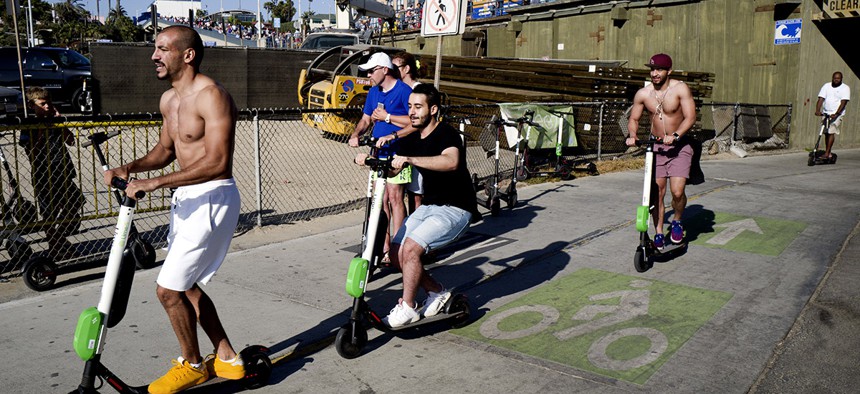Anatomy of an Electric Scooter Crash

People ride Lime and Bird scooters along the strand in Santa Monica, Calif. Richard Vogel/AP
The rise of the rented e-scooter has also brought safety fears and injury-related lawsuits. What happens when a new mobility mode meets the American legal system?
Grace heard a gasp, then the line went dead.
It was a freezing night—my hands were numb, my toes icy—but I’d wanted to call her, my college roommate, on the way home from work, so I took a scooter instead of a subway. I figured I could jam my wireless headphones in, talk, and ride. Before you ask: No, I was not wearing a helmet, and yes, it was winter-dark at 7 o’clock.
So I was stupid, maybe, and distracted, definitely. But as I zipped through Washington D.C.’s Dupont Circle—where just this September a scooter rider died after being struck by an SUV—my Bird suddenly slowed, then stopped entirely. It fell, and I fell with it. The call was dropped. “Holy shit Sarah are you okay,” Grace texted.
I’ve been an avid user of shared electric scooters since the things descended on D.C. last spring, accepting the risk therein. I’d hopped on various models with broken brakes before, only to swiftly hop off and park safely. I’d heard others complain about sticky accelerators. This sudden motor failure, however, was new. It didn’t seem to be a battery issue—the charge had been at 75 percent when I hopped on; 66 percent when I locked it, shaken, after. Something had gone very wrong.
When the issue of e-scooter safety is raised—and, if you spend any time talking to people in cities where this polarizing new urban mobility mode has emerged, it will—scooter fans like to counter with this stat: Cars kill 40,000 Americans a year, and they emit climate-warming gases while doing it. While scooter-related emergency room visits appear to be on the rise since these little dockless vehicles hit America’s roads, hard numbers about their serious injury rate remain elusive. The CDC plans to conduct its first epidemiological scooter study in Austin, Texas, to better quantify the public health risks they may or may not pose.
Some scooter-safety panic might be attributable to their sheer novelty. We’ve become immune to the daily toll of automotive crashes. And disruptive transportation technologies often brings fears, some legitimate: Early airplanes were said to upset chickens on the farms below; 19th-century bicycles afflicted riders with “bicycle face,” doctors once warned. But part of successfully introducing a new mode of transportation—especially one with revolutionary environmental potential—is figuring out how to get its users from point A to B intact, preferably without annoying or hurting others in the process.
Along with the e-scooter backlash have come the lawsuits. Perhaps the most high-profile case was filed in October, when Bird and Lime, along with two manufacturers of the vehicles they use, Segway and Xiaomi, became the subject of a putative class action suit filed in Los Angeles County Superior Court. Nine plaintiffs accused the companies of “indiscriminate, negligent, grossly negligent and/or unlawful ‘deployment’ … of fleets of defective” scooters in the city. The case is still pending.
Faced with legal challenges like this and threats of more citywide bans, the scooter industry has lately become more intentional about making safety a priority. Lime recently released an upgraded Gen 3 model with stronger safety features, like bigger wheels and extra rear brakes. Birds’ new Bird Zero models have gotten more rugged, too. In August, Bird also announced a plan to launch a Global Safety Advisory Committee focused on both rider and pedestrian wellbeing. To address charges that riders endanger sidewalk users, the company pledged to donate $1 per day per vehicle to building protected bike lanes in the cities where it operates.
NEXT STORY: Lawmaker Asks FCC for Emergency Briefing





